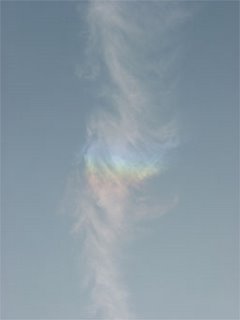 Late this afternoon, we saw this incredible cloud. The photo on the left is unedited.
Late this afternoon, we saw this incredible cloud. The photo on the left is unedited.Adjusting the
 light levels makes it look like this:
light levels makes it look like this:The rainbow is in the cloud.
Belinda found a name and explanation for this and another photo at NASA.
"They're called iridescent clouds. A relatively rare phenomenon known as iridescent clouds can show unusual colors vividly or a whole spectrum of colors simultaneously. These clouds are formed of small water droplets of nearly uniform size. When the Sun is in the right position and mostly hidden by thick clouds, these thinner clouds significantly diffract sunlight in a nearly coherent manner, with different colors being deflected by different amounts. Therefore, different colors will come to the observer from slightly different directions."
I don't know how you feel about it, but I don't find this explanation really helping much. I guess it's the "nearly coherent manner" that's throwing me off. Luckily the NASA site has a link to this site at the University of Wisconsin. I was a little discouraged by the introduction:
"To understand this phenomenon let's review the four basic theories of light. Each theory was derived at a different point in time and each has its advantages and disadvantages. None of the theories are completely satisfactory in that they can easily explain all the behaviors of light."
The article goes on to describe The Corpuscular Theory of Light, The Wave Theory of Light, The Electromagnetic Theory of Light and The Quantum Theory of Light. It turns out that iridescent clouds are best explained using Wave Theory. This is good 'cause it's the only one of the four that I know anything about.
I understand constructive and destructive interference, when two wave lengths are in-phase or out-of-phase. And I remember diffraction from high school physics.
"To summarize--light bends around objects (diffraction), how much it bends depends on the wavelength, white light is composed of all colors and each color has a different wavelength and therefore is diffracted by a different amount. When the light from the sun interacts with cloud droplets diffraction occurs--the light bends around the edge of the cloud droplet. Different colors are diffracted by different amounts and are therefore in-phase (and out-of-phase) at different distances from the sun. The color bands result as different colors are removed from the sun's light due to destructive interference, while other colors are enforced due to constructive interference."
So, as I understand it, diffraction (different wavelengths bending differently) makes the colors visible and constructive interference (when are in sync) makes the colors bright. I might be able to repeat this explanation tomorrow, but I hope I don't have to actually explain it to anyone.

7 comments:
We saw some of this spectacular light last spring... Your photos are breathtaking
It's a good thing I don't have to understand the body of this post to fully appreciate what a truly beautiful and awesome sight you were able to capture. For a minute there, I thought I might have to print this out and deconstruct it, sentence by sentence!
Hi Mary Ann - This looked very much like a sundog to me, so I did a little Internet search. The website Atmospheric Optics has some great photos and explanations. Your phenomenon appears to be a Circumzenithal Arc. Click on the image of the CZA on the web page to get to some great info. about it with more examples. Just for reference, all diffractive phenomena are in clouds or some other medium that has either water droplets or crystalline structures. Doesn't matter about the uniformity of the drops. I checked the website out with my husband, who's Professor Emeritus at the College of Optical Sciences, U. of Arizona, to make sure it's good stuff before I referred you to it. He says it is. Hope this helps.
Endment, yes, I'm really glad I got the pictures.
Melissa, I'll give up pursuing the explanation when it starts to detract from enjoying the phenomenon.
Pam, thanks for that link. I'm going to say it's a circumzenithal arc. It looks like sundogs have vertical spectra and occur at the same altitude as the sun. In my photos, the spectrum is horizontal and it was just about overhead. Although it's too narrow to be sure of the direction of the arc, the colors are "upside-down," that is, with violet at the top.
But sundogs is such a great name! Why not give CZA a better name - cloudpuppies or something...
I saw this in a cloud yesterday, and tried to remember this explaination in this post- no luck though!
It was beautiful, though.
I saw a sundog yesterday - someone said they usually occur in pairs on opposite sides of the sun - off to read that link!
Post a Comment